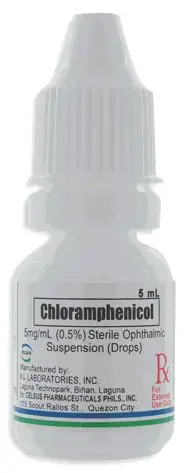Chloramphenicol eye drops are a common medication used to treat various eye infections and conditions.
As a broad-spectrum antibiotic, chloramphenicol is effective against a wide range of bacteria that can cause eye infections, including conjunctivitis, keratitis, and bacterial blepharitis.
In this comprehensive guide, we’ll explore everything you need to know about chloramphenicol eye drops, including their uses, dosage, side effects, precautions, and more.
Understanding Chloramphenicol Eye Drops

Chloramphenicol belongs to a class of antibiotics known as bacteriostatic agents, which work by inhibiting the growth and reproduction of bacteria. When used as eye drops, chloramphenicol can help treat bacterial eye infections by targeting the bacteria responsible for the infection and reducing inflammation and discomfort.
Uses of Chloramphenicol Eye Drops
Chloramphenicol eye drops are commonly prescribed for the treatment of various eye infections, including:
- Conjunctivitis: Chloramphenicol eye drops are often used to treat bacterial conjunctivitis, also known as pink eye. This common eye infection causes redness, itching, discharge, and irritation of the conjunctiva, the thin membrane that covers the white part of the eye and the inner surface of the eyelids.
- Keratitis: Keratitis is inflammation of the cornea, the clear, dome-shaped surface of the eye. Bacterial keratitis can occur due to eye injuries, contact lens wear, or exposure to contaminated water or foreign objects. Chloramphenicol eye drops may be prescribed to treat bacterial keratitis and prevent further complications.
- Bacterial Blepharitis: Blepharitis is inflammation of the eyelids, often caused by bacterial infections or other factors such as dry eye syndrome or meibomian gland dysfunction. Chloramphenicol eye drops can help reduce inflammation and manage bacterial blepharitis symptoms, including redness, swelling, and crusting of the eyelids.
Dosage and Administration
The dosage and administration of chloramphenicol eye drops may vary depending on the severity of the eye infection and the individual’s age and medical history.
It’s essential to follow your healthcare provider’s instructions and the medication label carefully. Typically, the recommended dosage for adults and children is one or two drops instilled into the affected eye(s) every two hours initially, followed by a reduction in frequency as the infection improves.
Precautions and Considerations
Before using chloramphenicol eye drops, it’s essential to consider the following precautions:
- Allergies: Inform your healthcare provider if you have a known allergy to chloramphenicol or any other medications. Allergic reactions to chloramphenicol eye drops are rare but can occur in some individuals.
- Pregnancy and Breastfeeding: If you are pregnant, planning to become pregnant, or breastfeeding, discuss the potential risks and benefits of using chloramphenicol eye drops with your healthcare provider. While chloramphenicol is generally considered safe to use during pregnancy and breastfeeding, caution is advised, and your healthcare provider may recommend alternative treatments if necessary.
- Contact Lenses: Remove contact lenses before instilling chloramphenicol eye drops and wait at least 15 minutes before reinserting them. Some eye drops may contain preservatives or ingredients that can interact with contact lenses.
- Children and Elderly: Use caution when administering chloramphenicol eye drops to children and elderly individuals, as they may be more sensitive to the medication’s effects. Follow your healthcare provider’s recommendations regarding dosage and frequency.
Also read: Eye Glasses in Ghana: Choosing the Perfect Pair!
Side Effects

While chloramphenicol eye drops are generally well-tolerated, they may cause side effects in some individuals. Common side effects may include:
- Mild Burning or Stinging: Some people may experience a temporary burning or stinging sensation in the eyes after instilling the drops. This usually resolves quickly and does not require treatment.
- Blurred Vision: Chloramphenicol eye drops may temporarily cause blurred vision or other changes in vision. Avoid driving or operating machinery if your vision is affected.
- Eye Irritation: In some cases, chloramphenicol eye drops may cause eye irritation, redness, or itching. If these symptoms persist or worsen, discontinue use and consult your healthcare provider.
- Allergic Reactions: Rarely, chloramphenicol eye drops may cause allergic reactions such as rash, itching, swelling, or difficulty breathing. Seek medical attention immediately if you experience any signs of an allergic reaction.
Conclusion
Chloramphenicol eye drops are a valuable medication for the treatment of bacterial eye infections, including conjunctivitis, keratitis, and bacterial blepharitis.
By understanding how to use chloramphenicol eye drops safely and effectively, you can help manage eye infections and alleviate symptoms while minimizing the risk of side effects.
If you have any questions or concerns about chloramphenicol eye drops or your eye health, don’t hesitate to consult your healthcare provider or eye care specialist. Your vision is precious, and proper eye care is essential for maintaining optimal eye health and well-being.




